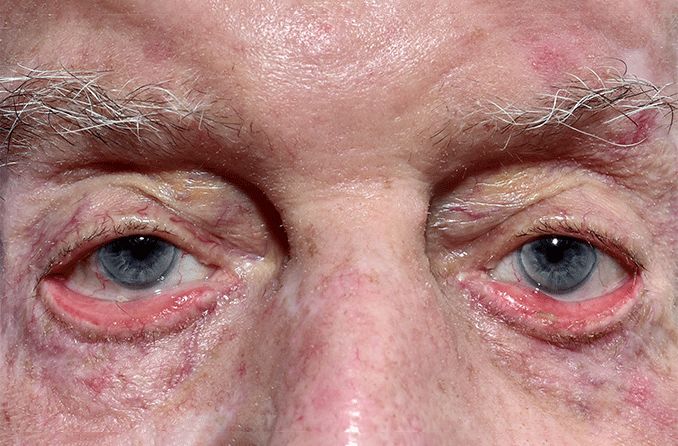Ectropion: Causes, symptoms and treatment

Ectropion (pronounced ek-TROH-pee-on) is a condition that causes the lower eyelid to sag downward away from the surface of the eye. It is most commonly caused by the natural weakening of tissue and muscle during the aging process and can cause eye dryness, irritation and excessive tearing. Ectropion can be treated with eye drops, taping the eyelid and surgery.
What is ectropion?
Ectropion, which is when the lower eyelid loosens and turns outward, leaves the inner eyelid and surface of the eyeball more exposed than normal. This can make the eye more susceptible to irritation and infection. If the lower eyelid sags or rolls outward enough, ectropion can keep the upper and lower lids from touching when the eye is closed, leaving the cornea exposed during sleep and potentially leading to more serious corneal conditions. Ectropion usually affects only one lower eyelid, but it can occur in both lower eyelids.
Involutional ectropion is the most common type of ectropion. During the aging process, the eyelid’s elastic fibers and collagen weaken and cause the tissue in the eyelid to loosen. Then, gravity can pull this lax tissue away from the eye. Other causes of ectropion include:
Cicatricial ectropion — Scars, previous eyelid surgeries, inflammation and other issues can cause a contraction or “shortening” of the eyelid tissue. A bacterial infection called trachoma can be caused by an eye injury, eye surgery complications or eye infection and lead to this type of ectropion.
Mechanical ectropion — When there is a lump, tumor or cyst on the eyelid, it can pull the eyelid down.
Paralytic ectropion — Facial paralysis, such as with Bell’s palsy, disrupts the nerves that control the eyelid and can affect eyelid muscles, leading to ectropion.
Babies are rarely born with ectropion, but when it does occur, it’s usually associated with a genetic disorder like Down syndrome wherein the muscles under the eyelid don't develop properly.
Symptoms of ectropion
This condition can keep tears from draining properly, as the lower lid is pulled away from the eye. Also, the inner lower eyelid is left exposed, causing the eye to become red, sore and irritated. Other ectropion eye symptoms include:
Gritty and dry eyes
Eye irritation
Frequent bacterial infections, such as conjunctivitis
Excessive watering (tearing)
Eye pain
Ectropion repair and treatment
In mild cases, using skin tape, an adhesive made specifically for the skin, can lift the lower lid to the cheek at night so that the edge of the lid and the lashes are in proper position while asleep. Be sure to ask your eye doctor for instructions and guidance before attempting this procedure.
Other possible remedies that may relieve discomfort include:
Wiping eyes gently and carefully from the outer eye and up toward the nose. Constantly rubbing watery eyes can weaken the muscles under the eyes and stretch tendons.
Using artificial tears and eye ointments to help keep the cornea lubricated and avoid vision damage. It is also helpful to wear a plastic moisture shield at night.
Ectropion surgery
If home remedies don’t improve the symptoms, surgery might be necessary, depending on your age and general health. The type of recommended surgery also depends on the state of the tissue surrounding the eyelid as well as the cause of ectropion.
Ligament and muscle relaxation: In order to tighten the muscles around the eyelid, a piece of the lower eyelid is removed. This procedure requires stitches below the eyelid or on the outside corner of the eye. This ectropion surgery will make it possible for the eyelid to sit properly on the eye.
Skin graft: It might be necessary to remove skin from behind the ear or from the upper eyelid to provide support to the lower eyelid.
After ectropion eye surgery, your doctor may recommend wearing an eye patch for the following 24 hours, as well as applying a steroid and antibiotic ointment to the eye several times per day for at least one week. Stitches are usually removed a week after surgery.
Temporary bruising and swelling will remain for at least two weeks post-surgery, so cold compresses are usually recommended. The eyelid might feel tight after the surgery but will become more comfortable as it heals.
Ectropion vs. entropion
Entropion and ectropion eye conditions both affect the eyelid. While ectropion causes the eyelid to turn outward, entropion forces the eyelid to turn inward, making the eyelashes and skin rub against the eye.
Both conditions generally affect only the lower lid. The symptoms of entropion are similar to ectropion and include:
Eye irritation and pain
Excessive tearing
Eye redness
Mucous discharge and eyelid crusting
Light and wind sensitivity
Ectropion and entropion can be caused by tissue laxity, muscle weakness, previous surgeries and scar tissue, eye infection, inflammation, and genetic disorders. Similar treatment options are available for each of these eye conditions.
READ MORE: More eye condition and diseases
Schedule an appointment with your eye doctor
Call your eye doctor immediately if you notice any sudden vision changes or worry you might be experiencing symptoms of ectropion. It’s important to keep up with regular eye exams, whether you need vision correction or not, so your eye doctor can watch for early warning signs of eye and other health conditions.
Page published on Wednesday, January 27, 2021




